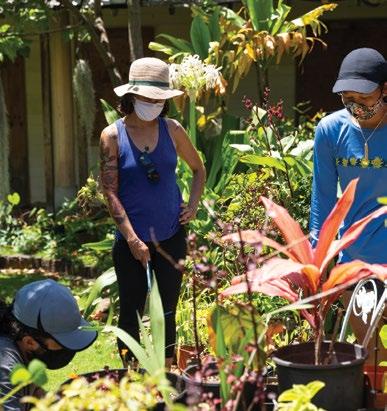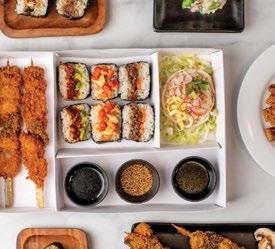
15 minute read
Pushing Boundaries: Sushi with Attitude
Pushing Boundaries:
SUSHI WITH ATTITUDE
Advertisement
AT CHAMINADE UNIVERSITY, WE TALK A LOT ABOUT ADAPTATION AND CHANGE— EDUCATING FOR ADAPTATION AND CHANGE IS ONE OF THE FIVE CORE TENETS OF A
MARIANIST EDUCATION. THE CONCEPT IS WOVEN THROUGHOUT OUR CURRICULA, AND OUR STUDENTS LEARN ABOUT THE IMPORTANCE OF EMBRACING CHANGE AND
ADAPTING TO MEET IT AS THEY MOVE THROUGH OUR PROGRAMS.
Adapting to change is something that is very familiar to Remi Kohno ‘15. She came to Chaminade University from Pasadena, California to play basketball and major in elementary education. But after her first year, she realized neither of those were the right fit. She didn’t like the competition she found on the basketball court, and teaching wasn’t her passion. So she quit the basketball team and switched her major to communications with a focus in marketing.
Her junior year brought even more change when she joined the Hogan Entrepreneurial Program. It quickly started pushing her out of her comfort bubble, and it altered the way she reacted to pressure.
“I saw all these great people join the Hogan program and I wanted to be just like them,” recalls Kohno. “Hogan definitely pushed my boundaries, which was nice. It really helped me grow as a person, both professionally and personally.”
Students who are accepted into the Hogan Entrepreneurial Program spend one or two years learning what it takes to become a successful entrepreneur. They mingle and network with some of Hawai'i’s biggest business leaders, they travel, they participate in internships and they work with industry leaders to design their own business plans and fine-tune their public speaking abilities.
The program helped Kohno break out of her shell and become more confident in her abilities to lead and engage.
One moment in particular stands out in her memory. Every Wednesday evening, Hogan participants gather to welcome and learn from a guest speaker from the Hawai'i business community. Guests range from Mattson Davis, the former president and CEO of Kona Brewing Co., to Chuck Cardinal, a former colonel in the United States Army and the former chief of staff to a WWII commander.
On this particular night, the speaker was Eddie Flores, Jr., the founder of L&L Hawaiian BBQ. Flores has an inspiring story—he’s the son of immigrant parents and the eldest of seven children. His family moved to Hawai'i from China when he was a young child. His father worked as a janitor, and his
mother worked as a restaurant cashier and dishwasher. He himself struggled with a learning disability growing up that kept him behind in school. But as a young man, he worked hard, ultimately earning enough money to buy his mother a restaurant in what would become the first L&L location. His restaurant chain now has over 200 locations, and in 2019 it was ranked as the No. 1 Asian food franchise by Entrepreneur.
Kohno had been designated as the evening’s notetaker, which meant it was her job to document Flores’ speech and at the end of the evening, stand up to present a recap to her classmates while Flores looked on.
She was just a little intimidated. “You’re listening and engaging, but you’re also taking notes so that you can structure it into a recap and presentation,” remembers Kohno. “After [Flores] was done, I had to go up in front of the whole class and do a quick overview of what was most important. It was nerve-racking. But then I got to give him a lei, which was nice and helped alleviate any tension.”
In Kohno's senior year, right after she had returned from a semester studying abroad in France, one of her professors recommended her for the American Advertising Federation’s Most Promising Multicultural Student program. She was one of only a handful of students selected from across the nation to participate in the intensive immersion program, designed to connect diverse up-and-coming advertising talent with some of the largest advertisers in the nation. She once again found herself at the airport, ready to embrace the unknown, this time in New York City.
Luckily, she had learned how to network and interact with business leaders through the Hogan program. “We got to meet a ton of people and tour their facilities and headquarters,” says Kohno. “It was an opportunity to connect with businesses and send them your resume, and hopefully get a follow-up interview to help jumpstart your career since college.”
Through all of the change and opportunity that came her way at Chaminade, Hogan taught Kohno to remain calm and collected, and cool under pressure. Through Hogan and her professors, she learned to see challenge as opportunity. It’s something that has served her well after college, particularly today.
Before COVID, her family ran a small restaurant stall called Sushi with Attitude at a night market in Los Angeles. While she has a full-time job at NBC during the day, she helps them on the side. When the pandemic shut down the market, they had to completely rethink their strategy and their focus. With Kohno’s help, they converted the business into a cloud kitchen model, meaning they are operating completely on delivery apps without a storefront, and launched a new product: the sushibi. It’s a combination of sushi and musubi.
“We wanted to offer musubi, but a lot of people in Los Angeles don’t know what they are,” says Kohno. “We also wanted to be able to show up in the sushi category on delivery apps—it is one of the most used keywords. So we rebranded our musubi to be sushibi to bridge the gap.”
The business has received a bit of media attention as a result, and Kohno’s Hogan training has come in useful.
“Hogan helped me learn to speak and structure what I’m going to say, which has helped a lot with media interviews,” says Kohno. “I recently interviewed with KTLA news. I was really nervous because it was live, but it was nice to be able to do something that I wasn’t really comfortable with, and Hogan taught me how to do that.”
Kohno attributes much of her recent success to Hogan and the opportunities she had at Chaminade. “Definitely Hogan, all of the professors I had at Chaminade and being part of the American Advertising Federation, they have all helped me grow into this role that I have right now.”
She works full-time as a manager in paid social media at NBC. And only five years after graduating from college, she feels like she’s almost landed her dream job.
“I love what I do at NBC. They’re a really great company,” says Kohno. “I want to continue to grow and become a director, and continue to be knowledgeable about all the various platforms and their nuances and updates. That is my dream goal. I think I’m almost there.”
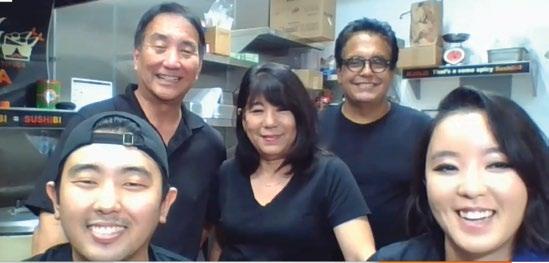
Shown above: Remi Kohno '15 and her family
COMING HOME TO CHAMINADE
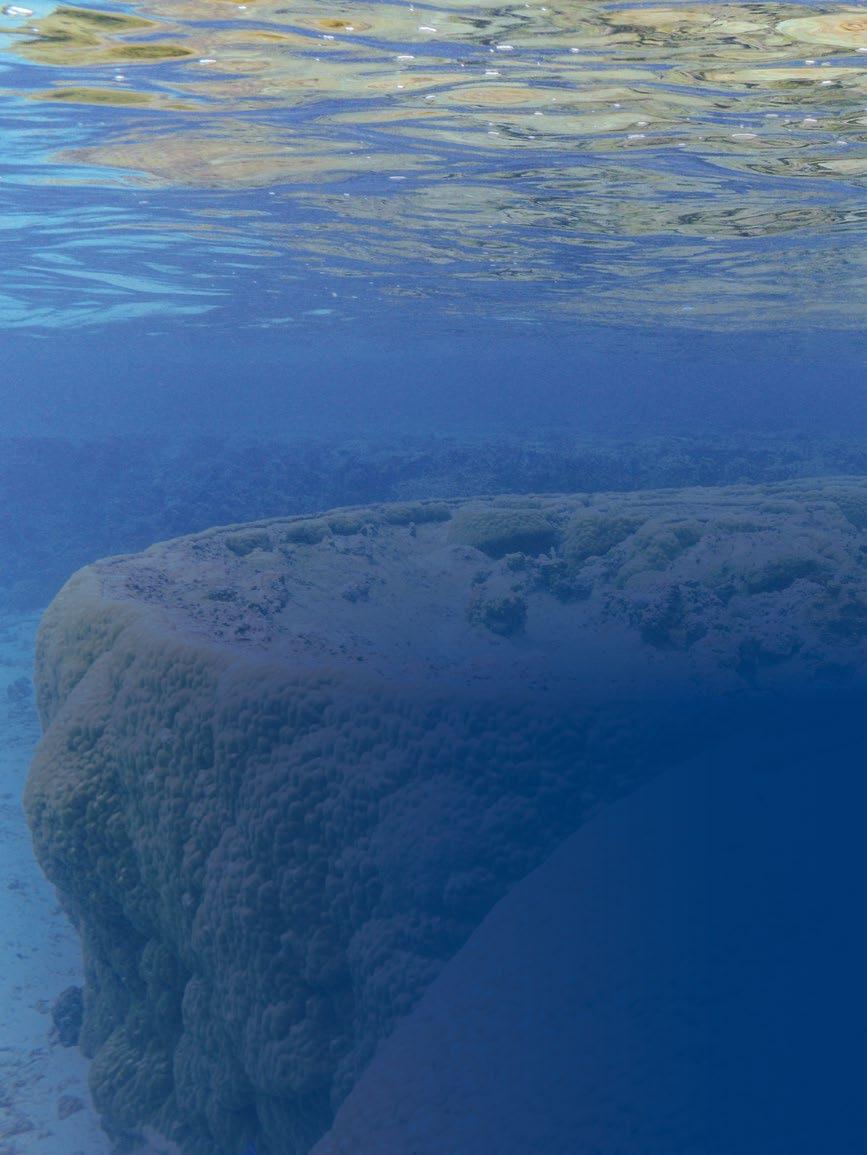
DR. LUPITA RUIZ-JONES, ASSISTANT PROFESSOR OF ENVIRONMENTAL SCIENCE AT CHAMINADE UNIVERSITY, WANTS
STUDENTS TO PLAN THEIR CAREERS WITH INTENTION SO THEY END UP DOING WORK THEY LOVE.
“I always want to remind students to pause, reflect, and ask themselves what they are curious and passionate about,” she says. “I want them to think about what brings them joy and gives meaning to the way they spend their time, so they don’t fall into a routine of checking boxes and then end up somewhere asking themselves, ‘How did I get here?’”
The key, she says, is pursuing and doing the things you are interested in, even when you don’t know where they will lead.
After all, that’s what worked for her.
She was in high school in Santa Fe, New Mexico when she attended a local shopping mall’s small college fair and happened to learn about Chaminade University. “It was very random,” she says. “I don’t think I ever would have heard of Chaminade except for that booth.”
She’d never been to Hawai'i, but she’d lived on Sicily for a year during high school, where she loved living on a volcano in the Mediterranean. That had been her first time exposed to marine environments.
“In college, I wanted to study human impacts on the environment, and I was also very keen to get out of the desert,” she says. Chaminade offered a major in environmental studies, and she was sold.
GOING FOR IT
Seeking out opportunities and going after them has been a lifelong pattern for Ruiz-Jones. It’s especially impressive when you learn she was raised by parents who didn’t complete college and in a family without the trappings of success.
Her mother was always supportive but struggled with bipolar disorder. Ruiz-Jones’ father went to prison when she was 12, which she says had a significant impact on her. “I really appreciated the ability to choose where I put my attention,” she says. She says she was fortunate to have scholarships and financial aid to help her pay for college.
In one of her first classes, Dr. Gail Grabowsky, now dean of the School of Natural Sciences and Mathematics, told the students it was great they were there. “She told us, ‘You’re going to love what you do, you’ll make an impact, but you’re not going to become rich.’”
“That was fine with me,” says Ruiz-Jones. “I saw my parents struggle and have no passion for their work. I felt like as long as I loved what I did and made an impact, that was what was important to me.”
During her freshman year, she applied and was selected for a five-week summer program in India that usually only accepted upper-level students.
“The goal of that trip was to see what small nonprofits were doing in India,” she says. “It wasn't science at all. It was really about human wellbeing and the different ways people were contributing by doing service to the really poor. We spent most of our time going to slums and eating with kids. It was an incredible experience. Very intense.”
The group included three students from Chaminade and two from the University of Dayton, a fellow Marianist school. They spent a couple weeks at a center where Marianist brothers taught a trade to boys whose families couldn’t afford to care for them or who were abandoned. They also volunteered at Mother Teresa’s center in Kolkata, working with toddlers abandoned by their family due to the children’s sickness or disease..
“The extent of the poverty and how many people are living and bathing and eating in the street was overwhelming,” she says. “But it was also really amazing to meet people who had dedicated months or years to doing what they could at that very small scale through immediate contact with people.”
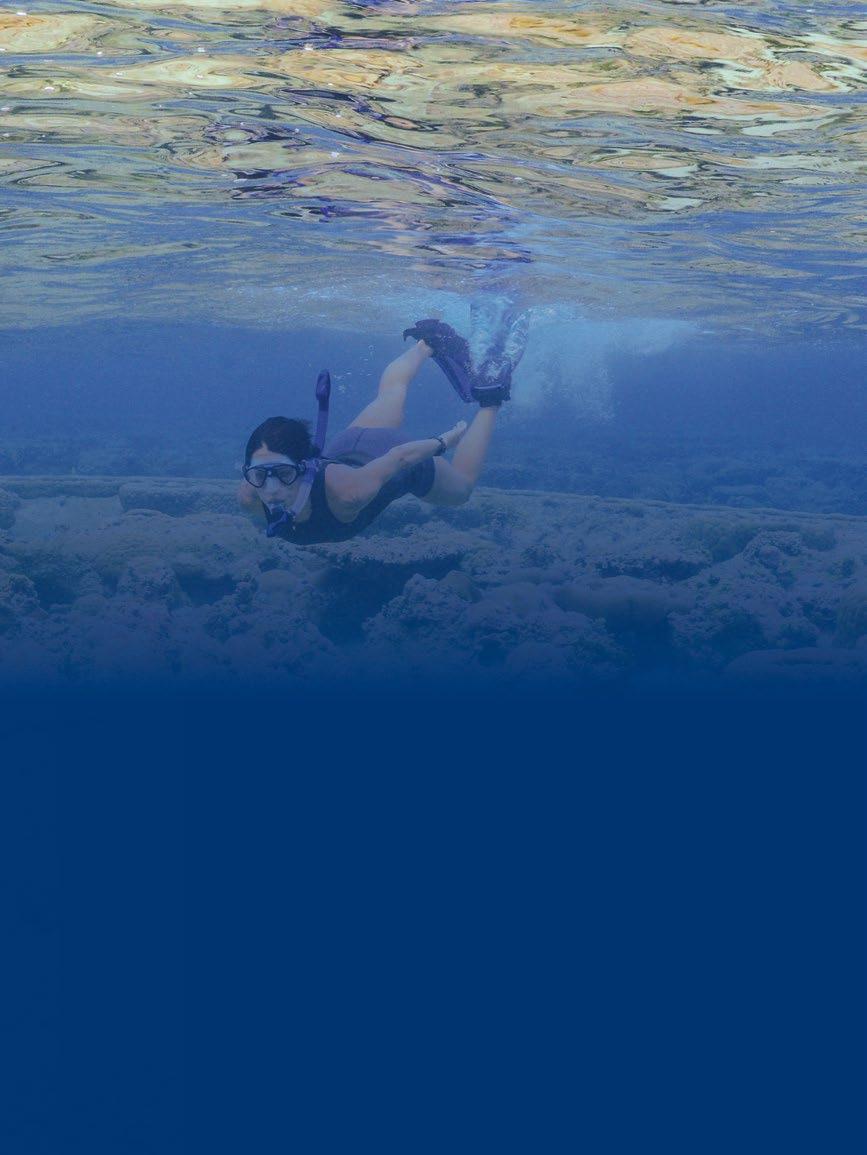
Dr. Lupita Ruiz-Jones doing field research in American Samoa during graduate school
EVOLUTION OF A PLAN
Although Ruiz-Jones ultimately earned a Ph.D. in coral ecophysiology, she started out interested in human well-being and the history of conflicts between nations. Later, when she applied to graduate school, her dream job was to work for the United Nations' environmental program.
But the summer after her sophomore year at Chaminade, she started doing undergraduate research at Kewalo Marine Lab. That’s where she first got excited about biology and organisms in coral reefs.
“Dr. Gail had this book about sea slugs that live in coral reefs,” she says. “I think she must have lent it to me at some point. I would sit there and flip through the pictures of these sea slugs. They're so colorful and beautiful. I actually ended up buying that book later on.
“I think a lot of my motivation to pursue science came from the joy I felt in being in nature and seeing its beauty. Kewalo was also where I started to realize that it's great to be aware of how we're damaging the environment. But I also was fascinated about doing science, gathering data, and asking very specific questions that could be addressed. Not these giant daunting tasks or challenges like addressing poverty.”
At the end of her summer research at Kewalo Marine Lab, her advisor, Dr. Mike Hadfield, invited her to continue there in an internship that ultimately stayed for the rest of her school years, including summers.
Hadfield also pushed her to take all the science courses she could, even though she didn’t need them for her environmental studies degree.
Taking those extra science courses pushed her into a fifth year of college. She didn’t mind, though, because she wanted to participate in a Sea Education Association summer-at-sea sailing program that focused on environmental studies. She’d learned about the summer program from a flyer she saw outside Dr. Gail’s office.
She applied, was accepted, and then spent four weeks in Woods Hole, Massachusetts, during that final summer of her undergrad career. Then back to Hawai'i, where students spent four weeks sailing to San Francisco on a tall ship.
“Wow, that was a really powerful experience,” she says. “We did biological oceanography research. I focused my project on invertebrates that live on the surface out in the middle of the ocean.”
At first, she found the semester at sea very challenging because she was seasick
for three full days. “I was miserable, and I got really depressed because you can’t get off the boat, right? But finally I got used to it. And then I thought, ‘Oh my gosh, this is amazing. This is so fun.’ But those first three days were excruciating.’”
GRADUATE SCHOOL
After graduating with her bachelor’s degree, she stayed on at the Marine Lab for an additional year, where Dr. Hadfield offered her work on a tree snail project.
“He's a Hawaiian tree snail scientist who also does a lot of marine biology,” she says. “The job was writing five-year status reviews for endangered Hawaiian tree snails, which was new for me. I got to do really cool things, like we took a couple helicopter rides up to the ridges of the Ko'olaus and the Wai'anae [Range], and we would camp out and look for tree snails that are going extinct.
“But mostly I spent time summarizing other people's research and writing reports. I think it motivated me to go to grad school even more. I was thinking, ‘I want to be doing my own research.’”
Dr. Hadfield encouraged her to apply to Stanford University for graduate school. She did, was accepted, and spent her first year on the Stanford campus. For the second year, the marine biology students moved to Stanford’s Hopkins Marine Station at Monterey, about an hour and a half away.
“One of the main reasons I selected the lab I did, Steve Palumbi’s lab at Stanford, was because he was doing work on coral reefs and he had a field site in American Samoa,” she says. She loved spending time on the beautiful, rural island of Ofu in American Samoa and getting familiar with the community and the reef there. She also appreciated returning to the U.S. through Hawai'i and maintaining her connections there.
BECOMING A TEACHER
After graduating Stanford with her Ph.D., she received the Thinking Matters Teaching Fellowship and spent four years team-teaching there. That, she says, is where she developed her identity as a educator and her love for teaching.
Since she was off during the summers, she started collaborating with scientists at the Hawai'i Institute of Marine Biology. She found she liked the combination of teaching during the school year and doing research on Hawai'i’s coral reefs in the summers.
That’s how she ended up back at Chaminade, as an assistant professor this time, in fall 2020. Currently she teaches Introduction to Environmental Issues, Marine Environmental Issues and Lab, and Advanced Marine Science and Lab.
She talks about how important it is to seek out great mentors. “Recognize what you’re curious and passionate about and pursue those activities,” she says. “That will expose you to potential mentors in that field. It was my mentors who helped me to see opportunities in my future, and shaped my career path, which was really helpful. They had a huge impact, and I’m super grateful.”
Dr. Hadfield was one of her mentors. Dr. Gail was another. “She has so much energy and enthusiasm for the material and the students. I remember being in her classes and looking up at her and being so impressed. I remember thinking I could never be in front of a class like that. I could never stand up there and lecture. Now I think that's funny.”
STILL TO COME
Right now, she says, her goals are to find ways to integrate her passion for research, coral reef ecology, and restoration into her teaching. “I want to set something up where I'm successful at both developing good teaching pedagogy, finding ways to engage students, and also maintaining some research activity, which I think is definitely challenging when the teaching load is high.”
“But I want to find a way for students to get exposure to being outside and asking questions about what's going on so they can be in the reef, collect data that's valuable to community members, and bring that into the classroom as well.”
As for other future goals, she points to Chaminade’s amazing diversity of students from around the world and its unique setting.
“Our institution has the potential to become a place where students can really think about the important relationship humans have with nature. You see it so clearly on an island. A lot of our students are Pacific Islanders, and there’s the history of Hawai'i and the Hawaiian culture. There’s a very intimate relationship with and respect and stewardship for nature. I think Chaminade is really incredible in that way.
She says she’d love to take students on field trips to neighbor islands or other Pacific islands, referring to a month-long summer course Stanford teaches in Palau.
“If we could do something like that where we took students to more remote Pacific islands and did environmental education, that'd be very cool.”
